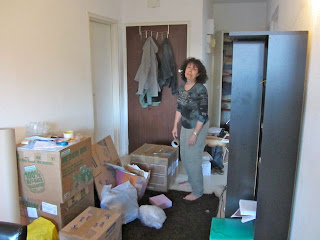 |
| Packing |
When we returned from our Bulgaria
trip, we spent 10 days sorting, discarding, and packing our belongings. How did
we accumulate so much in 10 months?
Assorted books bought, some clothes purchased, several household items
acquired at Ferney’s community-wide garage sale in September, a half dozen
black stones laden with fossils picked up from flat dry land (remnants of a
prehistoric sea) in Morocco during our Christmas vacation, two diminutive art
pieces obtained at Lyon’s Sunday artisan market, miscellaneous French food
items that are pricey in California… These acquisitions and others added to the
mass of items we had brought to France: suitcases of clothes for 4 seasons for
3 people; books to read and tour guides to use on trips; our computers and
cameras; art supplies; Spouse’s bike disassembled and packed in a secure,
stout, durable black plastic bike box.
We ended up with 9 suitcases to take with us on the plane, 8 boxes and the
bike crate to ship air freight, and 4 boxes of books to be
sent through the post.
We made trip after trip to Spouse’s
CERN office to store the suitcases and boxes because our apartment lease ended
on June 30, and our tickets back were for July 6. We stayed 5 nights in a hotel.
 |
| Storage at Spouse's CERN Office |
Our final day in the apartment was
sunny, humid, and the hottest of the summer: 35 degrees Celsius, or 95
Fahrenheit. With no air
conditioning, working nonstop to finish packing by 6 PM, then cleaning the
apartment, we were exhausted, sweaty, and tired. But that evening we attended a community-wide festival, La Fête à Voltaire, held on the grounds
of Voltaire’s chateau. Blue,
violet, and pink lights shined at different times on the chateau and church
(which Voltaire had built).
Different civic organizations from the area sold food and drinks. Not only could we buy traditional
French fare, like crepes or champagne, but we also could purchase food from
clubs of immigrants: Ethiopian, Moroccan, Haitian, Spanish, Russian, Tongan, West
African and others. On one stage a
group of costumed folk dancers and musicians from Bourg-en-Bresse, the largest
city in the département (province), performed and then taught dances to
attendees of the festival. And a
community chorus of adults sang a cantata by Jean-Philippe Rameau (1683-1764),
a contemporary of Voltaire. In
fact, Voltaire had written a libretto for one of Rameau’s operas, Samson, but it was never
performed because Rameau feared that Voltaire’s criticism of the Church would create
public discord.
 |
| Voltaire's chateau in violet light |
Between “La Fête à Voltaire” on
Saturday night – which seemed to be a suitable and sad adieu to Ferney - and
our departure the following Friday, we dined with friends we had seen
throughout the year and we toured places we hadn’t seen – a cheese factory in
the Jura Mountains and a medieval town with an interesting religious history,
both of which I’ll write about in the next few months.
 |
| Cheese factory in the Jura Mountains |
I drove around Ferney taking
last-minute photos of scenes I wanted to remember, such as the statue of nude lovers
which is located near the apartment where we lived, on a corner by the main
road that connects Ferney-Voltaire to Meyrin, Switzerland. We passed that statue at least twice a
day when I drove Spouse to and from CERN. Whenever I saw the sculpture, I assumed that Americans
would ban from public display such a carving of a couple embracing in the buff, and I thought,
“Vive la France!”
 |
| Embracing Nudes in Ferney-Voltaire |
The day before we left France we
took the boxes and bike crate to an air freight company at the
Geneva Airport.
 |
| Our air freight load |
And then on July 6, the three of us,
with our 9 suitcases and carry-on pieces, bid farewell to Ferney.
 |
| CERN Wife and luggage at Geneva Airport |
Although we didn’t spend an entire
year in Ferney-Voltaire, we are fortunate for having had 10 months to live in
France. CERN Wife, however, will
continue to write about French culture, which has been the subject of this
blog. But from now on, the blog
posts will be written in Oakland, California. France from not France. Now that’s interesting.













































